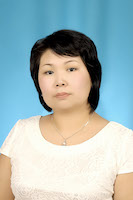Semantics of the secondary forms based on the participles on -byt and -gan in the Yakut and Tuvan languages
DOI:
https://doi.org/10.25178/nit.2020.1.11Keywords:
Yakut language; Tuvan language; participle; secondary forms; temporal distance; validity of action; perfectivity; mirativity; indirect evidentiality; relative timeAbstract
The article presents a comparative analysis of secondary forms that are based on semantically and functionally correlated participial forms in the Yakut and Tuvan languages. The forms ending in -byt and -gan occupy an important place in the verbal systems of the Yakut and Tuvan languages. In addition, these most striking typical Turkic participles, while retaining their proper participial functions, and acting in the sentence as a modifier, are used as a predicate in the main and dependent parts of the sentence. In their predicative function, they stand out among the main indicators of the past tense. These forms have the additional performance values and the temporal distance of the distant action. In combination with various affixes, service words and certain auxiliary verbs, the -byt and -gan forms create a number of synthetic and analytical secondary structures.
The semantic structure of the system of secondary finite forms based on the -byt and -gan forms in the Yakut and Tuvan languages shows the direction of further development of their basic semantics in these languages. In the Yakut language, the 12 secondary -byt actualize the semantics of temporal distance, and the reliability of actions in the past. As a result, the meaning of the perfect is rethought to add the semantics of retelling and the admirative. In the Tuvan language, the meanings of mirativity, or indirect evidentiality, also developed into 4 secondary which make use of the -gan form.
Secondary analytical structures combining the et-, -byt and -gan with auxiliary verbs of being regularly convey the meaning of the past relative and plusquamperfect, reflecting the general trend of building the system of relative tenses similar to the ones in other Turkic languages. Combinations of participles express grammaticalization of semantics of pretended action in -byt and -gan with auxiliary verbs buol- / bol-, which is typical for many Turkic languages.
References
Boktu-Kirish, Bora-Shaeley: Tuva ulustuң maadyrlyg toolu [Boktu-Kirish, Bora-Shaeley: a Tuvan heroic legend] (1995) / compiled by Orus-ool, S. M. : in 5 vol. Kyzyl, Tuvan book publisher. Vol. IV. 224 p. (In Tuv.).
Doҕorduurap, M. (1952) Anygy Loҥkuuda [New Longkuda]. Yakutsk, Book publishing house. 163 p. (In Yak.).
Duyungar, M. (1996) Hөlegeler [The shadows]. Kyzyl, Tuvan book publisher. 112 p. (In Tuv.).
Korkina, E. I. (1970) Nakloneniya glagola v yakutskom yazyke [The moods of the verb in Yakut language]. Moscow, Nauka. 308 p. (In Russ.)
Kudazhy, K. (1984) Taңdy kezhii [The gift of the taiga]. Kyzyl, Tuvan book publisher. 218 p. (In Tuv.).
Kuzhuget, M. (2005) Idegel [Hope]. Kyzyl, Tuvan book publisher. 96 p. (In Tuv.).
Mongush, D. A. (1983) O sluzhebnyh funktsiyah slov kizhi, ulus i chүve v tuvinskom yazyke [About the service functions of words man, people and thing in the Tuvan language]. In: Tyurkskie yazyki Sibiri [Turkic languages of Siberia]: a collection of research papers. Ed. by M.I. Cheremisina. Novosibirsk, Publishing House of SB AS USSR. 170 p. Pр. 12–35. (In Russ.)
Mongush, D. A. (1998) Chastitsy kak komponent analiticheskikh skazuemykh [Particles as a component of analytic predicates]. In: Yazyki korennykh narodov Sibiri [Languages of Indigenous Peoples of Siberia]:. A collection of research papers. No. 4. Ed. by M. I. Cheremisina. Novosibirsk, Publishing House of the SB RAS. 270 p. Рр. 122–153. (In Russ.)
Mongush, D. A. (2009) Tuvinskii iazyk i pis'mennost': Izbrannye Trudy [Tuvan Language and Writing: Selected Works]. Kyzyl, GUP RT «Tyvapoligraf». 248 p. (In Russ.).
Omolloon, S. (1967) Talyllybyt ajymn'ylar [Featured Works]. In 2 vol. Yakutsk, Book publishing house. Vol. II. 496 p. (In Yak.).
Oorzhak, B. Ch. (2018) Sistema grammaticheskoy modal'nosti v tuvinskom yazyke (v sopostavlenii s tyurkskimi yazykami Sibiri) [The system of grammatical modality in the Tuvan language in comparison with the Turkic languages of Siberia]. Diss. … Doctor of Philology. Kyzyl. 507 p. (In Russ.)
Pavlov, N. (Tyaһyt) (1970) Kuuһuma [Kuz’ma]. Yakutsk, Book publishing house. 88 p. (In Yak.).
Salchak, A. Ya. (2004) Peredacha znacheniya simulyativnosti v drevnetyurkskom i v tyurkskikh yazykakh Yuzhnoi Sibiri [The semantics of simulation in the ancient Turkic and Turkic languages of Southern Siberia]. In: Yazyki korennykh narodov Sibiri [Languages of Indigenous Peoples of Siberia]: a collection of research papers. No. 14. Ed. by M. I. Cheremisina. Novosibirsk, Publishing House of the SB RAS. 236 p. Рр. 48–52. (In Russ.).
Saryg-ool, S. (1961) Aңgyr-oolduң toozhuzu [The tale of a bright boy]. Kyzyl, Tuvan book publ. 210 p. (In Tuv.).
Saryg-ool, S. (1977) Hүnnүң yraazhylary [Singers of the sun]. Kyzyl, Tuvan book publisher. 442 p. (In Tuv.).
Sofronov, A. I. (1927) Oloh d'eberete [Swamp of life]. Yakutsk, National book publishing house. 60 p. (In Yak.).
Sysolyatin, I. (1996) Hahyjah [Birch]. Yakutsk, Book publishing house. 276 p. (In Yak.)
Filippov, G. G. (2014) Prichastiya yakutskogo yazyka: kompleksnoe tipologicheskoe funkcional'no-semanticheskoe issledovanie [The participles of the Yakut language: a comprehensive typological functional-semantic study]. Yakutsk, Publishing House of Northeastern Federal University, 607 p. (In Russ.).
Hudyakov, I. A. (1969) Kratkoe opisanie Verhoyanskogo okruga [Brief description of Verkhoyansk district]. Leningrad, Nauka. 440 p. (In Russ.)
Chadamba, L. (1978) Chogaaldar chyyndyzy [Featured Works]. Kyzyl, Tuvan book publisher. 302 p. (In Tuv.).
Cherlig-ool, K. (1990) Ayalga [Melody]. Kyzyl, Tuvan book publisher. 192 p. (In Tuv.).
Shamina, L. A. and Ondar Ch. S. (2003) Glagol'nye analiticheskie konstrukcii s pervym prichastnym komponentom v tuvinskom yazyke [Verbal analytical constructions with the first participial component in the Tuvan language]. Novosibirsk, Publishing house of Novosib. State University. 238 p. (In Russ.)
Shcherbak, A. M. (1981) Ocherki sravnitel'noi morfologii tyurkskikh yazykov. Glagol [Essays on the Comparative Morphology of Turkic Languages: Verb]. Leningrad, Nauka. 183 p. (In Russ.).
Eristiin, E. (1954) Talyllybyt ajymn'ylar [Featured Works]. Yakutsk, Book publishing house. 544 p. (In Yak.).
Yakutskaj, N. (1955) Kөmүsteekh үrүje [Golden stream]. Yakutsk, Yakutsk, Book publishing house. 240 p. (In Yak.).
Published
How to Cite
Filippov G. G. and Oorzhak B. Ch. Semantics of the secondary forms based on the participles on -byt and -gan in the Yakut and Tuvan languages. The New Research of Tuva. 2020, № 1. URL: https://nit.tuva.asia/nit/article/view/915 (access date ...). DOI: 10.25178/nit.2020.1.11
Issue
Section

Author(s) license holder(s) grant rights for their work to the journal (grantee of a license) under the simple non-exclusive open license in accordance with Art. 1286.1 «Open license for a research work, work of literature or fine arts», Civil Code of the Russian Federation.
New Research of Tuva publishes articles under the Creative Commons Attribution-NonCommercial license (CC BY-NC).
Since it is an open license, author(s) reserve the right to upload the article to their institutional repository, submit it to another journal (if it allows republications), or republish it on their own website (in full, or in part).
However, several conditions apply here:
a) The republished version must always contain the name(s) and affiliation(s) of the author(s), the original title and the hyperlink to the original version on the New Research of Tuva website;
b) It must be in open access, free of charge, and no category of readers must be in any way whatsoever advantaged over general readership.
c) should the contribution be submitted elsewhere by its author(s) without substantial modification (30% or more of original text unchanged), the body of the article should contain a disclaimer that the original version was published in New Research of Tuva (with a link to the respective page)
The CC-BY-NC is a non-revocable license which applies worldwide and lasts for the duration of the work’s copyright.










